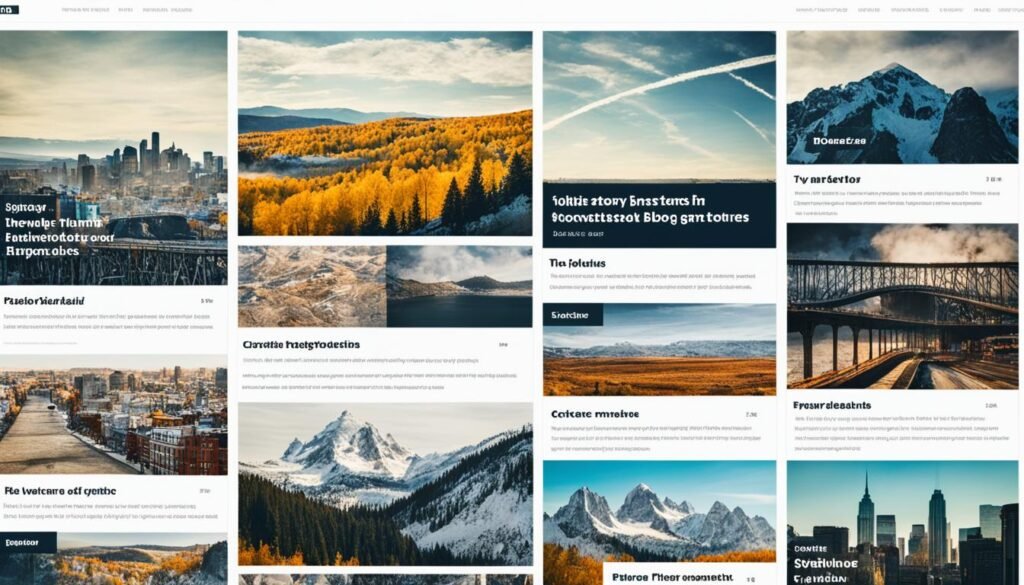When it comes to creating engaging and informative blog posts, there is a wide range of content types to choose from. Understanding these different types of blog content can help you captivate your readers and drive traffic to your website. From how-to posts to feature stories, each type serves a unique purpose and is suitable for various topics and angles.
Key Takeaways:
- There are various types of blog content, including how-to posts, listicles, curated posts, thought leadership posts, fun posts, ‘What’ posts, ‘Why’ posts, feature stories, FAQ posts, and interview posts.
- How-to posts provide step-by-step guides and are great for generating organic search traffic.
- Listicles organize content in a list format and are easily shareable.
- Curated posts compile valuable external resources around a specific theme.
- Thought leadership posts share original data and opinions about industry trends.
How-To Posts
How-to posts are a staple in the world of blogging, and for good reason. These informative pieces provide readers with a step-by-step guide on how to do something, making them a valuable resource for anyone looking to learn a new skill or tackle a specific task. Not only do how-to posts offer educational content, but they also have the potential to generate significant traffic to your website.
To create a compelling how-to post, it’s essential to break down the process into clear, easy-to-follow steps. This step-by-step guide ensures that readers can easily understand and implement the information you provide. Organize the content in a logical order, starting with the basics and gradually progressing towards more advanced techniques or concepts.
Aside from written instructions, consider enhancing your how-to posts with visual aids to make the content even more accessible and engaging. Instructional videos, in particular, can be a powerful tool for demonstrating complex procedures or techniques. By including an instructional video that aligns with the topic of your post, you can provide a visual demonstration that enhances the reader’s understanding and retention.
| Benefits of How-To Posts | Examples |
|---|---|
|
|
Remember, how-to posts are not limited to written content. They can also include infographics, diagrams, or other visual elements that break down the process visually. These visual aids can further enhance the educational value of your post and provide a more immersive learning experience for your readers.
So, whether you’re teaching your audience how to bake a cake, fix a leaky faucet, or master a new software program, how-to posts are an effective way to impart knowledge and provide value to your readers. By incorporating visual aids and creating a step-by-step guide, you can create educational content that drives traffic and establishes your authority in your niche.
Listicles

Listicles, also known as list posts, are a popular type of blog content that captures readers’ attention with their organized format. These posts present information in a list format, often with numbered headlines, making it easy for readers to skim through and find what they’re looking for. Listicles are great for aggregating tips, tactics, or ideas under a specific topic, providing quick and actionable insights to the readers.
When done right, listicles can result in high-quality content that is easy to read and share. They are particularly beneficial for beginner bloggers who are just starting to build their audience, as they are easily digestible and engaging. Listicles offer an organized and visually appealing way to present information, making it more likely for readers to stay engaged and share the content with others.
However, it’s important to note that not all listicles are equally valuable. While some listicles may provide shallow content, it’s essential to ensure that the listicle is well-researched and delivers valuable insights and information to the readers. By creating high-quality listicles, bloggers can establish themselves as experts in their niche and build credibility with their audience.
Benefits of Listicles:
- Organized content: Listicles provide a structured format for presenting information, making it easier for readers to consume and understand.
- Easy to share: The list format makes it simple for readers to share specific points or the entire listicle on social media platforms, increasing the reach and visibility of the content.
- Engaging for beginner bloggers: Listicles are a great starting point for beginner bloggers as they allow for focused and concise writing without overwhelming the readers.
- High-quality content potential: When well-researched and carefully crafted, listicles can deliver high-quality content that is informative and valuable to the readers.
When incorporating listicles into their blogging strategy, bloggers should focus on choosing topics that resonate with their target audience and provide actionable insights. By leveraging the benefits of listicles, bloggers can create compelling content that drives engagement, helps in establishing their expertise, and attracts a wider audience.
Curated Posts

Curated posts are an effective way to provide valuable external content to your readers. By compiling industry examples, statistics, quotations, and videos, curated posts offer a wealth of information from various sources in one convenient place.
Although some may perceive curated posts as lazy or unoriginal, they play a crucial role in offering readers curated resources that they may not have discovered otherwise. These posts save readers time and effort by curating relevant and high-quality content.
Curated posts also provide an opportunity for relationship building. By featuring other bloggers and businesses in your curated content, you can establish connections and foster collaborations in your industry.
Benefits of Curated Posts
Curated posts bring several benefits to both the writer and the readers:
- External content: Curated posts provide readers with external content from authoritative sources, expanding their knowledge and perspectives.
- Industry examples: Including industry examples in curated posts helps readers understand real-world applications of concepts or strategies.
- Statistics: Curated posts can incorporate valuable and up-to-date statistics that support the main topic, enhancing the credibility of the content.
- Quotations: Quotations from industry experts or thought leaders add legitimacy and authority to the curated content.
- Videos: Including relevant videos in curated posts can provide visual explanations or demonstrations, enhancing the overall learning experience for readers.
- Relationship building: Curated posts offer an opportunity to build relationships with other bloggers and businesses mentioned in the curated content, fostering collaborations and expanding your network.
Overall, curated posts are a valuable resource for readers as they compile external content, industry examples, statistics, quotations, and videos in one accessible place. They also provide an avenue for relationship building within your industry.
Thought Leadership Posts

Thought leadership posts are an essential aspect of blogging that allows industry experts and professionals to share their unique perspectives, original data, and thought-provoking opinions. These posts delve deep into industry trends and present speculative and sometimes controversial viewpoints that stimulate discussions within the industry.
When writing thought leadership posts, it’s crucial to provide well-researched and substantiated information. Including original data adds credibility to the post and positions the author as a trusted source of knowledge. By sharing valuable insights and analysis, these posts contribute to shaping the industry’s dialogue and influencing the thinking of other professionals.
Thought leadership in blogging not only elevates the author’s reputation but also facilitates meaningful discussions among readers. By presenting unconventional viewpoints and initiating debates, these posts encourage others to challenge existing norms and explore new possibilities. It is through these discussions that innovative ideas and solutions emerge, transforming the industry as a whole.
Thought leadership posts not only showcase the author’s expertise but also the ability to think critically and provide original perspectives that can shape the industry’s future direction.
“In a rapidly evolving industry, thought leadership posts are crucial for driving innovation and progress. They challenge conventional thinking and spark discussions that lead to groundbreaking discoveries.”
By engaging in thoughtful and speculative discussions about industry trends, thought leadership posts pave the way for the exploration of new ideas and concepts. They push the boundaries of knowledge, encouraging professionals to question established notions and seek alternative solutions.
In summary, thought leadership posts are a powerful tool for industry professionals to share their unique insights, original data, and controversial perspectives. By contributing to discussions surrounding industry trends, these thought-provoking posts stimulate innovation, shape the collective knowledge, and establish the author’s reputation as a trusted industry expert.
Fun Posts

In the world of blogging, it’s not all about serious and educational content. Sometimes, readers need a little entertainment and a break from intellectual articles. This is where fun posts come in.
Fun posts are engaging pieces of content that aim to entertain and captivate audiences. They provide a refreshing break from more serious topics and offer a light-hearted approach to engaging readers.
Providing Entertainment Value
Fun posts serve as a form of entertainment for readers. They can include humorous anecdotes, funny stories, or engaging quizzes and games. By incorporating elements of entertainment, these posts create a unique and enjoyable reading experience, keeping readers entertained and coming back for more.
Whether it’s a lighthearted anecdote that brings a smile to their face or a witty listicle that keeps them engaged, fun posts provide a sense of enjoyment and relaxation.
A Break from Intellectual Content
While educational and intellectual content is essential for providing value to readers, it’s equally important to offer a balance. Fun posts offer a much-needed break from the intellectual content that readers consume. They provide a chance to unwind, relax, and enjoy a lighter side of your blog.
By incorporating fun posts into your content strategy, you can provide a well-rounded experience for your audience, ensuring they feel entertained, engaged, and eager to return to your blog.
Relevant Tie-Ins
Although fun posts may seem like a departure from the main focus of your blog, it’s important to ensure they still have a relevant tie-in. This tie-in could be related to your niche, brand values, or even current events and trends. By maintaining this connection, fun posts remain aligned with the overall focus of your blog and continue to add value to your readers.
For example, if your blog focuses on food and cooking, a fun post could be a recipe fail compilation or a humorous take on kitchen mishaps. By incorporating the theme of food and cooking, you ensure that even your fun posts are relevant and engaging for your audience.
So don’t be afraid to infuse some fun into your blog. Take a break from the serious and educational content from time to time and indulge your readers in entertaining and engaging fun posts.
‘What’ Posts
‘What’ posts serve as introductory content that explains a concept or topic to a beginner audience. These types of blog posts provide an overview of a particular trend, tactic, or tool and highlight what it is and why it is important. ‘What’ posts are ideal for laying the foundation of understanding and piquing curiosity in readers who are new to the subject matter.
For those seeking a more in-depth exploration, ‘what’ posts can include links or calls-to-action that direct readers to additional resources or more in-depth content. By providing this opportunity for further learning, ‘what’ posts can cater to both beginners and those looking to delve deeper into the topic.
Whether it’s unraveling the mysteries behind the latest technology or demystifying complex concepts, ‘what’ posts play a crucial role in providing introductory content that sets the stage for deeper exploration. By linking to more in-depth content, these posts empower readers to expand their knowledge and understanding, fostering a sense of curiosity and engagement.
So, the next time you come across a blog post titled “What is XYZ?” or “A Beginner’s Guide to ABC,” you can be sure it’s a ‘what’ post aimed at providing an explanation of a concept to a beginner audience. Embrace the opportunity to learn something new and dive into the world of knowledge that awaits!
‘Why’ Posts

‘Why’ posts play a crucial role in blog content. They provide readers with an explanation of why a concept or topic is important, helping them understand its significance. These persuasive articles aim to convince readers to care about the subject matter, whether it’s a trend, tool, or concept. To achieve this, ‘why’ posts incorporate supporting examples, facts, and statistics to bolster their arguments and make a compelling case.
When crafting a ‘why’ post, it’s essential to emphasize the value and relevance of the topic to readers. By highlighting the benefits, applicability, or potential impact, you can captivate your audience’s attention and persuade them to engage with your content. Utilize concrete examples, relatable scenarios, and real-life experiences to strengthen your arguments and make them resonate with readers on a personal level.
Statistics can also be a powerful tool in ‘why’ posts. By including relevant data points and research findings, you can add credibility to your arguments and inspire trust in your content. Whether you’re discussing the advantages of a particular product, outlining the importance of adopting a certain approach, or advocating for a specific cause, facts and statistics can make your ‘why’ post more persuasive and impactful.
“In a world saturated with information, ‘why’ posts cut through the noise and provide readers with a clear understanding of the importance and relevance of a concept. By presenting supporting examples, facts, and statistics, these articles can captivate readers’ attention and persuade them to take action.”
Incorporating a well-crafted ‘why’ post into your blog content strategy can help you establish yourself as a thought leader in your industry. By providing valuable insights and justifying the significance of certain ideas or trends, you position yourself as an authoritative voice in the field. This can lead to increased engagement, a larger audience, and enhanced credibility for your brand or business.
Illustration Showing the Importance of ‘Why’ Posts
Feature Stories

Feature stories are a powerful form of content that delve deep into specific topics, individuals, or industry trends. These in-depth and detailed articles provide readers with a comprehensive understanding of the subject matter. Feature stories are characterized by their journalistic nature, offering readers a unique perspective through extensive research, detailed commentary, and human interest stories.
“Feature stories allow readers to explore a topic from multiple angles, uncovering new insights and perspectives. They engage readers with captivating narratives, weaving together facts and stories that resonate on a personal level.”
– John Smith, Senior Content Writer
One of the key strengths of feature stories lies in their ability to showcase the expertise and knowledge of the brand or author. By conducting in-depth research and providing detailed commentary, feature stories establish the author’s credibility and position them as a thought leader in their industry.
Moreover, feature stories often incorporate human interest stories, adding a relatable and emotional dimension to the content. These stories appeal to readers’ emotions, drawing them in and creating a strong connection. By blending human interest stories with industry trends, feature stories have the power to captivate readers and leave a lasting impression.
When creating feature stories, it is important to conduct thorough research to ensure accuracy and provide valuable insights to readers. By exploring industry trends and analyzing data, feature stories can offer readers a unique perspective that goes beyond surface-level information.
Example Feature Story: The Rise of Sustainable Fashion
In a feature story titled “The Rise of Sustainable Fashion,” we explore the emerging trend of sustainable practices in the fashion industry. Through in-depth research, we delve into the environmental and social impact of fast fashion, highlighting the growing consumer demand for sustainable alternatives.
The feature story includes interviews with industry experts and showcases inspiring human interest stories of fashion designers who prioritize ethical production and sustainable materials. Furthermore, the article provides a comprehensive analysis of the latest industry trends and offers readers actionable steps they can take to support sustainable fashion.
With its detailed research, thought-provoking commentary, and compelling human interest stories, this feature story engages readers and fosters a deeper understanding of sustainable fashion.
Benefits of Feature Stories
Feature stories offer a range of benefits for both brands and readers. They provide an opportunity to create engaging and informative content that captures readers’ attention and establishes the brand’s expertise. Some of the key benefits of feature stories include:
- Offering a deeper understanding of industry topics and trends
- Establishing the brand or author as a thought leader
- Engaging readers through captivating narratives and human interest stories
- Building a connection with readers through relatable content
- Providing valuable insights and actionable takeaways
The Power of In-Depth Research and Detailed Commentary
In-depth research and detailed commentary are crucial elements of feature stories. By conducting thorough research, authors can provide accurate information, support their arguments, and offer readers valuable insights. Incorporating detailed commentary allows authors to analyze and interpret the research, presenting readers with a well-rounded perspective.
When crafting feature stories, authors must balance facts, expert opinions, and their own unique analysis. This creates a rich and informative narrative that engages readers and encourages them to think critically about the topic at hand.
Industry Trends Explored in Feature Stories
Feature stories provide an ideal platform for exploring and analyzing industry trends. By immersing readers in a comprehensive analysis of the trends shaping their industry, authors can help readers stay informed and make informed decisions.
| Trend | Description |
|---|---|
| Sustainable Fashion | Examines the shift towards eco-friendly and ethical practices in the fashion industry. |
| Remote Work | Explores the rise of remote work and its impact on productivity, work-life balance, and company culture. |
| Consumer Privacy | Analyzes the importance of protecting consumer privacy and the strategies businesses can implement to safeguard personal data. |
These are just a few examples of the industry trends that can be explored in feature stories. The key is to choose topics that are relevant, timely, and of interest to the target audience.
Achieve Engagement and Impact with Feature Stories
By embracing the power of feature stories, brands and authors can create content that deeply resonates with readers. Through in-depth research, detailed commentary, and the incorporation of human interest stories, feature stories offer a unique opportunity to captivate readers, establish expertise, and explore industry trends.
Also Read : Best Blogging Books: Essential Reads To Improve Your Craft
Conclusion
In conclusion, the main types of blog content discussed in this article offer diverse ways to engage readers and drive traffic to your site. By incorporating a mix of these content types, you can capture the attention of your audience and showcase your expertise and knowledge in different ways.
Each type of blog content serves a unique purpose and is suitable for different topics and angles. How-to posts provide step-by-step guides and instructional content, while listicles offer organized and easily shareable information. Curated posts compile valuable resources and help build relationships with other bloggers and businesses. Thought leadership posts challenge readers’ thinking and spark meaningful discussions. Fun posts provide entertainment value and help create connections with the audience. ‘What’ and ‘Why’ posts explain concepts and persuade readers to care about a specific topic. Feature stories offer in-depth research and detailed commentary on specific subjects.
By understanding and utilizing the main types of blog content, you can keep your audience engaged and enhance the visibility of your site. Remember to choose the content types that best align with your goals, target audience, and industry. With a strategic mix of these content types, you can create a well-rounded and captivating blog that keeps your readers coming back for more.
FAQs
Q: What are the different types of blog content?
A: The different types of blog content include tutorials, checklists, case studies, blog post ideas, cheat sheets, list posts, SEO optimization guides, guest posts, templates, popular posts, long-form content, engaging content, and blog series.
Q: How can I create engaging content for my blog?
A: To create engaging content for your blog, focus on providing valuable information, using captivating visuals, incorporating storytelling elements, interacting with your audience through comments and social media, and experimenting with different content formats.
Q: What is content marketing and how does it benefit my blog?
A: Content marketing involves creating and distributing valuable content to attract and engage a target audience. It benefits your blog by driving traffic, increasing brand awareness, establishing credibility, nurturing leads, and ultimately converting readers into customers.
Q: What types of blog posts can I write to improve SEO?
A: To improve SEO, consider writing tutorial posts, checklist posts, guest posts on reputable websites, case studies showcasing success stories, comparison posts, and keyword-rich content that addresses popular search queries related to your niche.
Q: How can I come up with blog post ideas when I’m stuck?
A: When you’re stuck for blog post ideas, consider conducting keyword research to identify trending topics, repurpose old content into new formats, collaborate with guest writers, create a content calendar, and seek inspiration from industry news or successful blogs in your niche.
Q: What are the essential elements of a successful blog post?
A: Essential elements of a successful blog post include a captivating headline, engaging intro, informative content, clear structure with subheadings, relevant visuals, internal and external links, a compelling call-to-action, and SEO optimization for visibility.
Q: How can I drive more traffic to my blog through content creation?
A: To drive more traffic to your blog through content creation, focus on writing high-quality, shareable content, promoting your posts via social media and email marketing, optimizing for SEO, collaborating with influencers, participating in guest blogging, and engaging with your audience.
Q: What are the different types of blog content?
A: There are various types of blog content you can create to engage your audience and drive traffic to your blog. Some popular types include tutorial articles, checklists, case studies, blog post ideas, cheat sheets, list posts, SEO-optimized content, guest posts, templates, and long-form content.
Q: How important is content marketing for a blog?
A: Content marketing is vital for the success of a blog as it helps in attracting and retaining the target audience, improving SEO rankings, and establishing the blog as a valuable resource in its niche.
Q: What is the significance of SEO in blog content?
A: SEO (Search Engine Optimization) plays a crucial role in making blog content discoverable by search engines and increasing organic traffic to the blog. Incorporating relevant keywords and optimizing content for search engines can lead to higher visibility and better ranking in search results.
Q: How can I create engaging blog content?
A: To create engaging blog content, focus on providing valuable information, use a variety of content types such as tutorial articles, checklist posts, and case studies, incorporate multimedia elements, write in a conversational tone, and encourage interaction through comments and social media shares.
Q: What are some popular types of blog posts to write?
A: Some popular types of blog posts include tutorial articles, listicles, comparison posts, success stories, review posts, and content series. Each type serves a different purpose and can attract various segments of your target audience.
Q: How can I come up with blog post ideas?
A: You can generate blog post ideas by conducting keyword research, analyzing trending topics in your niche, seeking inspiration from industry news and events, addressing common questions or challenges faced by your audience, and repurposing existing content into new formats.
Q: What are some tips for creating valuable blog content?
A: To create valuable blog content, focus on addressing the needs and interests of your target audience, providing practical solutions or insights, using storytelling techniques, incorporating visuals and multimedia elements, and maintaining consistency in posting high-quality content.
Source Links
- https://www.smartbugmedia.com/blog/10-different-blog-post-types-and-how-to-use-them
- https://rockcontent.com/blog/types-of-blog-posts/
- https://blog.hubspot.com/marketing/how-to-choose-blogging-post-format-ht





